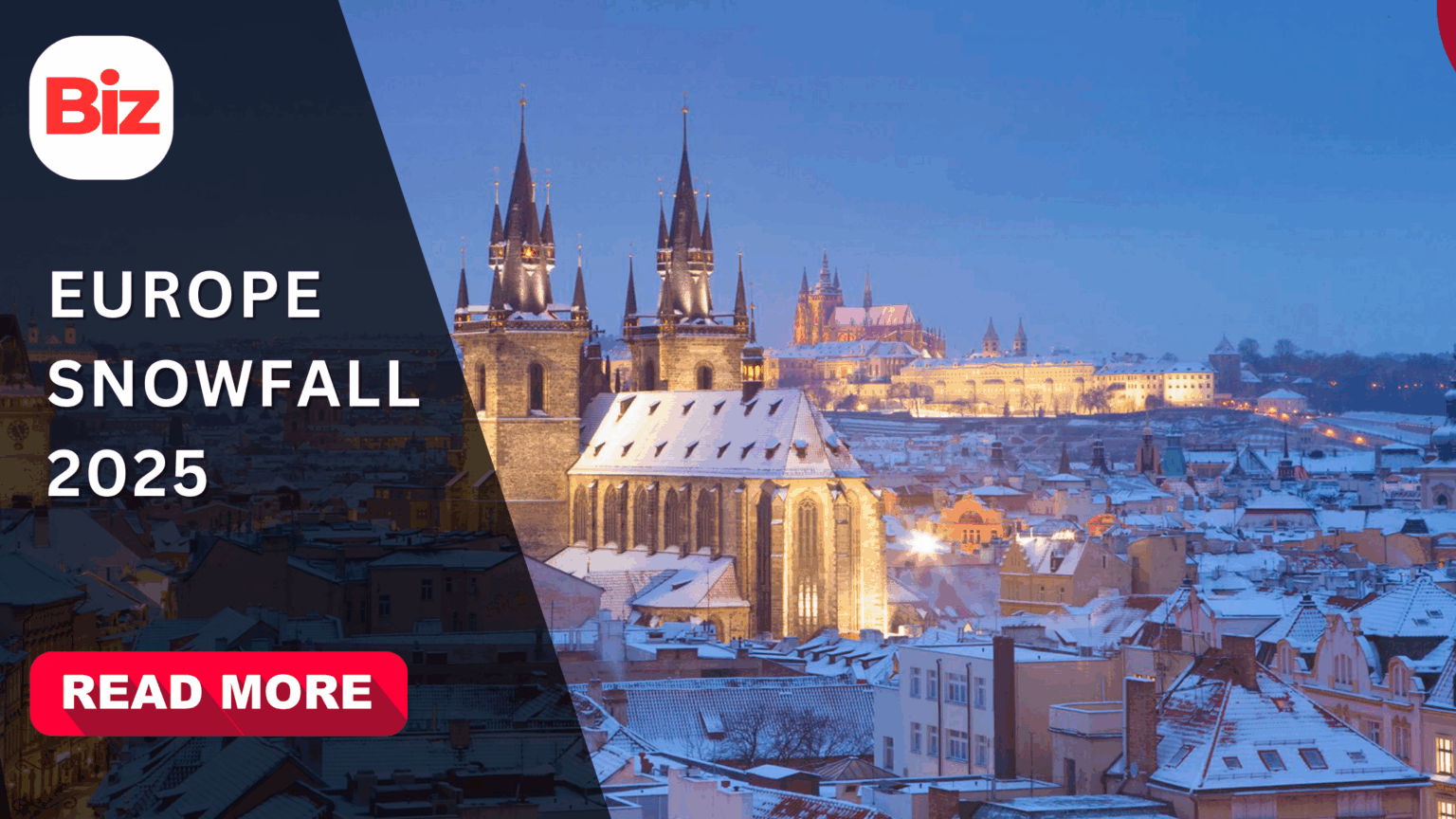The snowfall has been the characteristic of winter in Europe. Snow is an aesthetic gift, and has its forces to reckon with, even in the snow-swept Alps and the frozen Baltic coasts, in the old cities filled with dust, and in the snows on the high mountain-passes. However, over the past decades, the amount, timing, and reliability of snowfall in Europe are shifting with significant consequences to the nature, society, and the economy.
What falls like snow in Europe.
Europe is very diverse in climatical terms and this is represented in snowfall patterns.
High mountains and alpine country (Alps, Carpathians, Pyrenees, Scandinavian range):Large amount of snow falls especially in high places. The amount of snowfall is closely linked to winter sports, the nature of glaciation, snowpack formation, avalanche potential.
- Northern and Eastern Europe: Areas such as Scandinavia, Russia and some of the Baltic area tend to receive regular snow cover throughout the winter but often at lower elevations.
- Central Europe: Snow is typical here, although it is quite variable. The winters are snowy, and there are mild winters.
- Southern and Mediterranean areas: Snow is less frequent and especially along coastal lowlands. Mountains receive snow, however, in an irregular manner.
Recent Observations and Changing Trends.
Over the last few years, scientists who have been monitoring the amount of snowfall in Europe have noticed certain evident changes – most of them associated with climatic change.
Reduction in snow in most places.
An analysis of the Alps in the period 1920 to 2020 reveals that the average reduction in the volume of snowfall in this region is about 34%.
This decrease is especially steep in the southwestern slopes, and at altitudes less than about 2,000 metres.
Less consistent snow cover.
The snow is later coming, melting earlier or even not coming where there was a dependable snow in former years. Within most mountain ecosystems, the length of time that the snow remains on the ground is decreasing.
Effects on water resources and glaciers.
During the winter seasons, glaciers will lose more ice than they will replace especially when the snow is light. The loss in the volume of glacier ice in Alps is increasing.
Climate Change Services provided by Copernicus.
Historically, Snowmelt provides rivers, which are used in agriculture, hydropower, and drinking (less snow means those rivers are less predictable).
Ski resorts and tourism have their snow reliability decreasing.
The low-altitude ski resorts, and quite a few others, are in danger. With further warming, the sustainability of winter tourism will be threatened by the lack of snow. One specific study indicated that more than 50 per cent of European ski resorts would be under very high risk in a warming situation.
Fluctuations and excessive snowing.
Extreme snow fall events remain possible even in case of overall declines. A large amount of snow can be received in a very short time by cold air masses, abnormal weather patterns or storms. These are prone to create interruptions transportation delays, avalanche danger, power cuts etc. As an illustration, the major disruptions in 2019 in the Alps and other areas were due to heavy snow.
There were also also news about the early snow/icy cold fronts in Central Europe that proved how these extremes shock people indirectly.
Effects of Decreasing Snowfall.
All dimensions of life are influenced by the changes in the amount of snowfall. Some of the largest ones are as follows:
Environmental / Ecosystems:
Snow cover is very sensitive to the alpine and mountain ecosystems. Snow is known to insulate soils, to affect the growing seasons, and to affect the moisture levels in soils. Less snow changes plant phenology (when to flower, when to set seeds), habitat of cold-adapted species and the slope stability (avalanches).
Hydrology & Water Resources:
Snowmelt contributes significantly to spring and summer rivers in most areas in Europe. Lesser amounts of snow or lesser amounts of retention would indicate lesser amounts of meltwater, which puts strains on water supplies, irrigation and hydropower.
Economy & Tourism:
Winter tourism (skiing, snowboarding, winter hiking) is based on regular snowfall. With less predictable or thinner snow, resorts are relying more on less predictable and when the weather is favorable artificial snow, which is costly, or fewer visitors. Snow touristic regions can lose money.
Infrastructure, Transport, and Safety:
Snow or even freezing rain incidents of heavy amount may disrupt roads, rail, air transport, electricity, communications. Accident risk is also brought about by snow and ice. Societies in lower temperate areas might not be well prepared in times of unusual snowfall.
Cultural & Social Effects:
Snow is a part of the seasonal identity (festivals, winter sports, rituals) in a variety of locations. Its decline disturbs cultural calibrations. There are also possible benefits of reduced snow days such as reduced recreation, snow play and so on.
Case Study: The Alps
The Alps are one of the most eloquent illustrations since so many dimensions are overlapping: high altitudes, reliance on snow and ice, tourism, hydroelectric energy, agriculture.
Snowfall has reduced by an estimated one-third of its volume during the last 100 years.
It is particularly large on southern and southwest sides of the chain of mountains and on altitudes lower than 2,000 m.
There are still winter seasons when a great deal of snow falls, and the recent cold waves have replenished the quantity of snow in many areas of the Alps to something near historical averages in individual years.
This demonstrates the fact that change is not homogeneous. Although in warmer climates, variability implies that there will be winters with snow, it is their frequency, reliability and distribution that changes.
Why Snowfall Is Decreasing: Drivers and Complexities.
To understand the reasons behind the declining snow, a few causes need to be looked into and these are interrelated:
Warming temperatures.
Winters are becoming warmer so they receive much precipitation in the form of rain as opposed to snow, particularly at low elevations. In addition, the seasons when the temperature is just above that of freezing do not allow snow to accumulate even with precipitation.
Shorter cold seasons.
Periods of freezes are less intense; there is less snow remaining over prolonged warmer intervals (melting, sublimation).
Precipitation patterns.
There are localities that are drying during winter or the moisture is not uniform. Even the higher altitude areas can receive some precipitation although it could be in the form of snow depending on the temperature.
Human land use.
Local reduction in snow retention can be caused by urban heat islands, deforestation and land cover changes. In addition, the snowpack also responds to wind, exposure to the sun, and conditions on the ground.
Severe occurrences and fluctuations.
Although the overall snowfall is decreasing, there are cases of cold snaps or storms that may cause the large amount of snowfall. However, these are becoming less predictable and communities might be less geared.
Predictions and Potentialities
According to the existing climate models and the ongoing research, there are a number of probable scenarios of the snowfall in Europe.
Additional loss of snow at the low altitudes. Snow may become irregular or scarce at many locations where snow used to be reliable during the winter season.
- Altitudinal change: Regions in higher altitudes will tend to have more snow; lower/valley ones will have less.
- Less dependability in winter tourism in mid-range resorts. Certain ski resorts are allowed to have short seasons, or rely on artificial snow.
- Hydrological stress: Fewer snowfall will cause run off not to arrive when it is supposed to, and the lack of water during summer will cause problems with hydroelectric energy.
- Growing significance of adaptation & mitigation. These would involve better predicting, infrastructure modifications (snowmelt, flood and avalanche risk), diversification of economies in snow-dependent areas, conservation or regeneration of natural landscapes that aid in snow-cover maintenance.
- The issue of climate policy (reducing emissions) is even more important: the warmer the world will be the more devastating the decreases will become. Nevertheless, due to warming, local and microclimatic processes will result in the fact that there will be snowfalls as well, only less often and less predictably.
Why This Matters
Snow is not simply beautiful landscape. It is a crucial part of the European environmental systems, cultural life and of numerous economies. Since snow-cover is no longer a sure thing:
- Areas that rely on snowmelt water may fail in agriculture.
- Hydro (and other types of energy systems) might be less reliable.
- Settlements in mountain areas can lose sources of livelihoods that are associated with winter tourism.
- The increased vulnerability to the natural hazards (avalanches, rapid snowmelt floods) may pose a risk to lives and infrastructure.
- Furthermore, smaller amounts of snow cover less sunlight are reflected (low albedo) and cause more warming, forming feedback loops in climate systems.
Conclusion
Europe is at the crossroads with snowfall. Whereas certain winters continue to provide impressive snowfall and dramatic scenery, the larger movement is towards less snow, less predictability and greater variation. The beauty and cheer of snow remains – children playing, skiers carving, photographers hunting dawn light on white peaks but the circumstances that favor those things are changing.
The problem is now two-fold to policymakers, the community, scientists and tourists alike: adapt to evolving realities (through planning, infrastructure, sustainable tourism, water management) and do something to mitigate the warming to leave behind the places and ecologies that rely on snow.








